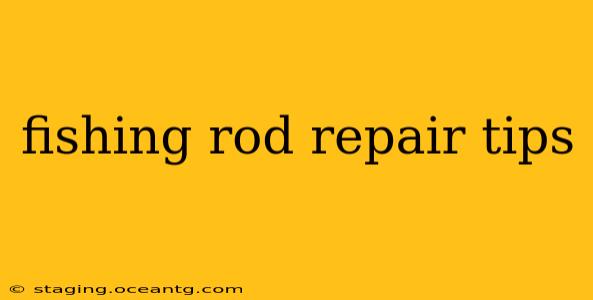Fishing rods, crucial tools for anglers, are susceptible to damage from wear and tear, accidental impacts, or even the elements. Understanding how to perform basic fishing rod repairs can significantly extend the lifespan of your favorite rod and save you money on replacements. This comprehensive guide covers common fishing rod repair tips, helping you get back on the water quickly.
What are the most common fishing rod repairs?
This is arguably the most frequently asked question regarding fishing rod repair. The most common repairs revolve around broken guides (also known as eyelets or rings), cracked or broken rod tips, and damaged reel seats. Occasionally, you might need to address superficial damage to the rod blank itself, but these are often cosmetic rather than functional.
How to repair a broken fishing rod tip?
A broken rod tip is a frustrating but repairable problem. While a perfectly matched replacement tip is ideal, it's often unavailable. Fortunately, you can often repair a minor break using epoxy resin and a section of similar diameter rod material, like a spare piece of rod or even a sturdy piece of carbon fiber tubing. Clean the broken surfaces thoroughly, apply epoxy, and carefully align the pieces. Allow ample curing time before testing the repair. Remember, the repair will weaken the tip slightly, so avoid applying excessive stress.
Can you fix a snapped fishing rod tip?
Yes, you can often fix a snapped fishing rod tip, but the success depends on the severity of the break and the type of rod. A clean break is easier to repair than a shattered tip. For complex repairs, consider taking it to a professional rod repair service.
How to repair a broken fishing rod guide?
Broken or damaged guides are another common issue. These guides are crucial for directing the fishing line smoothly. Replacing them is often necessary and thankfully relatively easy for many anglers.
You'll need replacement guides of the correct size and type (check your rod's specifications) and a suitable adhesive designed for high-temperature use, given the friction of the line. Carefully remove the old guide, clean the rod blank, apply the adhesive to the new guide's base, and carefully position it on the rod. Ensure it's aligned correctly before allowing the adhesive to fully cure.
How do you fix a loose fishing rod guide?
A loose fishing rod guide is usually due to the adhesive failing. You can try tightening it with epoxy resin. However, a proper repair often requires replacing the entire guide, following the steps outlined above. Avoid using overly strong adhesives that might damage the rod blank.
How to repair a damaged reel seat?
Reel seats, which secure the fishing reel to the rod, can crack or loosen over time. If the reel seat is simply loose, you can often tighten it by carefully applying a suitable epoxy adhesive, but this will only work if the actual seat is not damaged or cracked. For cracked or severely damaged reel seats, replacement is usually necessary, requiring some skill and potentially specialized tools. This repair is best left to an experienced rod builder or repair specialist.
How do I prevent fishing rod damage?
Prevention is always better than cure. Here are some preventative measures to keep your fishing rod in top condition:
- Proper Storage: Store your fishing rods in a rod case or protective sleeve, away from direct sunlight and extreme temperatures.
- Careful Handling: Avoid dropping or banging your rod against hard surfaces.
- Regular Cleaning: Wipe down your rod after each use to remove dirt, grime, and saltwater.
- Guide Inspection: Regularly inspect your guides for damage or wear.
By following these fishing rod repair tips and practicing preventive maintenance, you can extend the life of your fishing rods and ensure many years of successful fishing adventures. Remember, for complex repairs, seeking professional help might be the best option. Don't hesitate to reach out to your local tackle shop or a professional rod builder for assistance.
